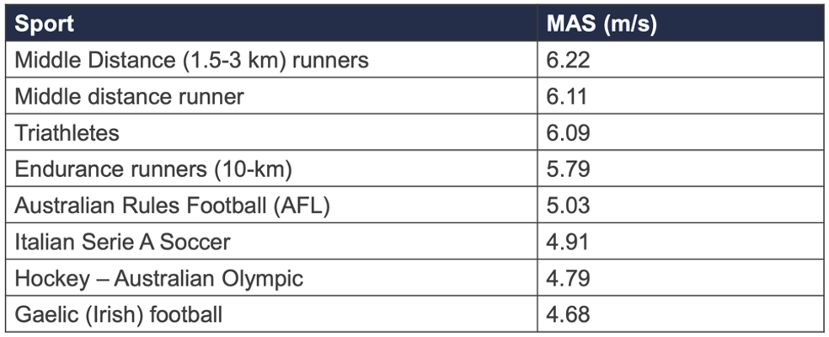What is MAS? And how to use it
A term that is becoming more and more widely used around the place is ‘maximal aerobic speed’ – or ‘MAS’. But what is MAS and how can you use it to personalise your own running?
What is MAS?
Maximal aerobic speed is defined as the minimal running speed at which maximal oxygen uptake (VO2 max) occurs – and is typically referred to as velocity at VO2 max. That is, you can continue to run faster than the speed at which you reach VO2 max, however at this speed more anaerobic contribution begins to occur (image below), hence why MAS is then simply the ‘slowest’ speed an athlete will achieve their VO2 max.
Outside of a laboratory, the MAS is simply the speed attained in the final leg of the Montreal Beep test (around a track or oval), but has also been shown to collate very closely with the speed attained during a 2km time trial. This has very practical implications for players looking to personalise their own running prescription – which we will get to shortly.
Why MAS not VO2?
Requiring a lab and expensive equipment to calculate in the first place, VO2 max is also not a useful measure for setting running paces and durations for training. So MAS has developed as an effective way of understand the physical demand of a training prescription – and as a result provides a simple and effective way of programming a training prescription.
What does it mean for training?
There is a growing body of research showing that the amount of time spent running at above 100% MAS is the critical factor in improving aerobic power. Or more specifically from a practical point of view, that performing a series of short intervals at a speed above 100% MAS is more effective method of building aerobic power than long slow distance (LSD) running. While this interval method has been known for quite some time, and indeed discussed in detail on this site for quite some time, MAS offers a good way of personalizing your own training in an easy way, without the need for a lab and a fancy gas analysis system.
Specifically 120% MAS for a short distance followed by passive rest has been shown to be the most effective.
This is great, how do I measure my MAS?
There are several methods that have shown to correlate very closely with MAS, that are quick, cheap, non-invasive, simple and repeatable to test, and then re-test when required. This ticks a lot of boxes in regards to what makes a good test.
MAS can be tested with either a time-based or distance-based method.
As mentioned, a 2km time trial has shown to correlate very closely, and is a nice round number (5 laps of an athletics track).
Alternatively, a maximum distance run in a limited time is the other option. 5-6 minutes is a good ball-park of the sort of time to set this up for.
The only requirement is that you are able to accurately measure how far you have covered when performing such a test, and can reproduce the test in the same conditions when you re-test (surface, route taken, same general weather conditions and time of day).
So once I have run 2km or 6 minutes, what next?
Lets say you ran the 2km time trial in 7.25.
The next step is to convert this 2km in 7.25 into a meters-per-second number.
First convert the minutes into seconds = 445 seconds.
Next divide the meters by these seconds = 2000m/445s = 4.5 meters/second.
That is, with your time trial time, your current MAS is 4.5m/s.
Is that good?
The time trial of 7.25 was just randomly chosen for explanation here, but for a quick reference, there are some MAS scores in the table below, taken from a review of the literature by Baker & Heaney in the Journal of Australian Strength & Conditioning. So when you test yourself, you can compare and see how you go relative to a few different types of athlete.

So an important take home here from this discussion is that when it comes to general training discussions, MAS is just a measure. It’s like 1RM. It’s not a type of training. It is a measure to prescribe intensities from.
How do I use my MAS score to plan my training
That will be where we take part 2 of this discussion. The all important practical application.
Strength Coach

